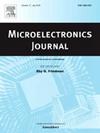p-hBN/AlGaN/GaN HEMT结构低暗电流光电晶体管的仿真研究
IF 1.9
3区 工程技术
Q3 ENGINEERING, ELECTRICAL & ELECTRONIC
引用次数: 0
摘要
在这项工作中,我们报道了基于p-GaN/AlGaN/GaN高电子迁移率晶体管(HEMT)结构的高性能紫外(UV)光电晶体管(PT)。在黑暗条件下,p-hBN HEMT基UV PT的导电通道被p-n结耗尽,导致在10 V漏极偏压下的低暗电流密度为2.29 × 10−12 mA/mm,相对于采用p-GaN HEMT结构的PT,其抑制了三个数量级。这可以归因于p-hBN层中较高的活化孔浓度引起的更强的耗尽效应。在0.5 mW/cm2紫外光照射下,光电流密度达到228.91 mA/mm。光暗电流比为1 × 1014。此外,还研究了结构参数对p-hBN hemt性能的影响。这些结果表明,基于p-hBN hemt的pt在紫外检测应用中具有应用潜力,为开发改进的紫外光电探测器提供了另一种策略。本文章由计算机程序翻译,如有差异,请以英文原文为准。
Simulation-based study of low dark current phototransistors with p-hBN/AlGaN/GaN HEMT structures
In this work, we report a high-performance ultraviolet (UV) phototransistor (PT) based on p-GaN/AlGaN/GaN high electron mobility transistor (HEMT) structure. Under dark conditions, the conducting channel of the p-hBN HEMT-based UV PT is depleted by the p-n junction, resulting in a low dark current density of 2.29 × 10−12 mA/mm under 10 V drain bias, which demonstrates three orders of magnitude suppression relative to the PTs employing p-GaN HEMT architectures. This can be attributed to the stronger depletion effect caused by the higher activation hole concentration in the p-hBN layer. Moreover, the photocurrent density reaches 228.91 mA/mm under 0.5 mW/cm2 UV illumination. The photo-to-dark current ratio is 1 × 1014. Additionally, the impact of structural parameters on the performance of p-hBN HEMT-based PTs is investigated. These results demonstrate that the p-hBN HEMT-based PTs have applicable potential in UV detection applications, suggesting an alternative strategy for developing improved UV photodetectors.
求助全文
通过发布文献求助,成功后即可免费获取论文全文。
去求助
来源期刊

Microelectronics Journal
工程技术-工程:电子与电气
CiteScore
4.00
自引率
27.30%
发文量
222
审稿时长
43 days
期刊介绍:
Published since 1969, the Microelectronics Journal is an international forum for the dissemination of research and applications of microelectronic systems, circuits, and emerging technologies. Papers published in the Microelectronics Journal have undergone peer review to ensure originality, relevance, and timeliness. The journal thus provides a worldwide, regular, and comprehensive update on microelectronic circuits and systems.
The Microelectronics Journal invites papers describing significant research and applications in all of the areas listed below. Comprehensive review/survey papers covering recent developments will also be considered. The Microelectronics Journal covers circuits and systems. This topic includes but is not limited to: Analog, digital, mixed, and RF circuits and related design methodologies; Logic, architectural, and system level synthesis; Testing, design for testability, built-in self-test; Area, power, and thermal analysis and design; Mixed-domain simulation and design; Embedded systems; Non-von Neumann computing and related technologies and circuits; Design and test of high complexity systems integration; SoC, NoC, SIP, and NIP design and test; 3-D integration design and analysis; Emerging device technologies and circuits, such as FinFETs, SETs, spintronics, SFQ, MTJ, etc.
Application aspects such as signal and image processing including circuits for cryptography, sensors, and actuators including sensor networks, reliability and quality issues, and economic models are also welcome.
 求助内容:
求助内容: 应助结果提醒方式:
应助结果提醒方式:


